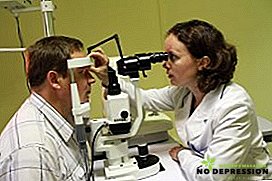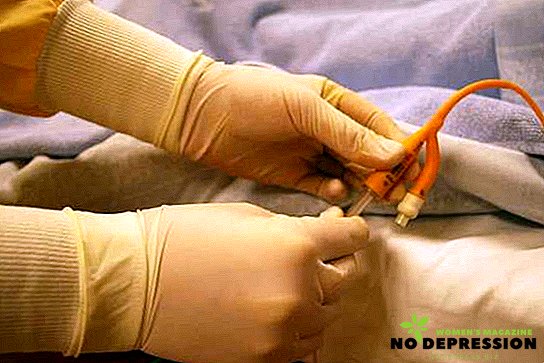There are many eye diseases in humans that manifest with various symptoms. Diseases of the organs of vision may be genetically determined, and may be bacterial and infectious. Having noticed the slightest manifestations of discomfort, one should consult with an ophthalmologist as soon as possible.

List of congenital eye pathologies
Eye diseases in humans can be congenital or acquired. Congenital pathologies include:
- cat eye syndrome;
- myopia;
- color blindness;
- optic nerve hypoplasia.
Cat Eye Syndrome
The disease is characterized by a change in the iris. The disease is genetically determined and develops as a result of a mutation in chromosome 22. In this disease, there is either a deformity or the absence of a part of the iris.
Due to the change of the iris, the pupil can be vertically stretched or displaced, due to this external manifestation of the syndrome and got its name.
In addition to eye damage, this pathology is often accompanied by a number of changes in the development of the body that are incompatible with life: defects of the rectum and absence of the anus, underdevelopment of the genital organs, renal failure, congenital heart defects.
The prognosis for this disease depends on the symptoms. With moderately pronounced symptoms of a genetic disease, the prognosis may be favorable, while with congenital malformations of the internal organs, the probability of an early death is high.
Color blindness
Another congenital eye pathology is color blindness or color blindness. With this pathology, the patient’s eyes cannot distinguish between certain colors, most often all shades of red and green.
The disease is associated with a congenital anomaly of the receptor sensitivity of the eyes (cones). The gene that causes the development of color blindness is transmitted from mother to son (X-linked recessive mode of transmission), so men suffer from this disease 20 times more often than women. The disease is not treated.
Optic nerve hypoplasia
This is a congenital pathology, which in some cases is accompanied by a reduction in the size of the optic disc. A severe form of hypoplasia is characterized by a complete absence of optic nerve fibers. Symptoms of the disease:
- blurred vision;
- weakening of the muscles of the eye;
- "blind spots" in the field of vision;
- violation of color perception;
- impaired motility of the pupil.
The weakening of the muscles of the eyeball can lead to the development of pronounced strabismus. Optic nerve hypoplasia can be corrected at an early age.
Myopia
Myopia or myopia can be either congenital or acquired pathology. Congenital myopia is caused by an increase in the eyeball, resulting in an impaired image formation.
The visual "picture" is formed in front of the retina, and not on it, like in a healthy person. Patients with this disease poorly distinguish objects located at a remote distance. Depending on how much the eyeball is enlarged, myopia can be of three types - weak, medium and high degree of myopia.

An increase in the eyeball causes retinal stretching. The higher the degree of myopia, the more the retina stretches, and therefore the higher the likelihood of developing secondary eye diseases on the background of myopia. Complications of myopia include:
- retinal dystrophy due to its excessive stretching;
- retinal detachment;
- retinal hemorrhage;
- glaucoma.
Visual acuity is corrected with glasses.
Patients with myopia of medium and high degree should regularly visit an ophthalmologist to check the status of the retina. Complications of this disease can occur at any age, so it is important to track any changes in the retina and fundus in a timely manner.
Corneal diseases in humans
The following cornea diseases are distinguished:
- keratoconus;
- keratitis;
- corneal clouding.
Corneal diseases can occur at any age. Keratoconus is characterized by changes in the structure of the cornea. Keratitis develops due to infection.
A widespread disease, especially in old age, is corneal clouding, popularly called the thorn.

Keratoconus
Keratoconus is a non-inflammatory eye disease that is characterized by thinning and deformation of the cornea. A healthy cornea has a spherical shape, but as a result of degenerative changes in keratoconus, it is deformed and stretched, acquiring conical outlines.
Pathology develops due to the violation of the elasticity of the fibers of which the cornea is composed. In most cases, the disease affects both eyes.
Keratoconus is a disease of young people, the disease develops at the age of 14-30 years. Degeneration of the cornea fibers takes a long time, the disease slowly progresses over 3-5 years. Causes of the disease - endocrine disorders and eye injuries. Also, fiber degeneration may be due to genetic predisposition.

Symptoms of myopia and astigmatism are characteristic of keratoconus. Astigmatism is manifested by vision distortion. The peculiarity of keratoconus is the difficulty of correcting vision with the help of glasses. Because of the signs of astigmatism, there are problems with sharpness and focusing even when wearing glasses.
Treatment of curtoconus is aimed at stopping the progression of changes in the cornea. This is achieved by exposure to UV rays with the use of special medicines.
Progressive keratoconus leads to a noticeable thinning and protrusion of the cornea. In this case, the correction of vision with glasses and lenses is impossible, so a corneal transplantation is performed.
Keratitis
Keratitis is inflammation of the cornea of the eye. There are the following types of the disease:
- infectious;
- traumatic;
- allergic keratitis.

In most cases, infectious keratitis is diagnosed. This disease develops as a result of a viral, bacterial, or fungal infection. Keratitis is characterized by severe inflammation, redness and swelling of the cornea.
A traumatic form of inflammation develops when exposed to aggressive chemicals, or as a result of damage to the cornea.
Factors predisposing to the development of keratitis are systemic disease (diabetes, gout), reduced immunity, the presence of a chronic focus of infection.
Patients who wear contact lenses often experience the disease. Careless installation of the lens, or neglect of the rules of storage, can cause damage to the cornea.
Symptoms of the disease:
- corneal clouding;
- dilation of blood vessels;
- lacrimation;
- burning and dry eyes;
- photophobia;
- Pain in the eyes;
- blepharospasm.
Blepharospasm is a condition in which it is impossible to open your eyes wide.
The danger of keratitis is the risk of scarring and irreversible corneal opacification. The treatment is carried out in the hospital. Therapy is selected depending on the cause of the development of inflammation.
In case of bacterial infection, treatment with drops and antibiotic ointments is used. For fungal infections, antimycotics are used to treat the eyes.
For the treatment of viral keratitis apply drugs in the form of ointments and drops based on interferon. In case of a severe form of the disease, physiotherapeutic treatment methods are additionally prescribed. Keratitis allergic nature are treated with drops, blocking the release of histamine.

Corneal opacity
An eye catcher is a corneal clouding. Among the causes of the development of pathology:
- corneal inflammation;
- transferred infectious and viral diseases;
- untreated conjunctivitis;
- burns and corneal injuries;
- lack of vitamins.
 Often an eyesore is due to improper wearing of contact lenses. Neglect of the rules of cleaning lenses leads to the accumulation of pathogenic microorganisms that affect the cornea and cause inflammation.
Often an eyesore is due to improper wearing of contact lenses. Neglect of the rules of cleaning lenses leads to the accumulation of pathogenic microorganisms that affect the cornea and cause inflammation.
One of the common complications of keratitis becomes irreversible corneal clouding. Corneal opacity is visible to the naked eye. Pathology is characterized by the formation of turbid areas. Opacification can occupy a large area of the cornea.
An eyesore is accompanied by photosensitivity, tearing and impaired visual acuity.
Treatment of turbidity depends on the cause of the development of pathology. For infection of the cornea and conjunctiva, antibacterial drops and ointments are used.
If the pathology is viral, the doctor determines the causative agent of inflammation, and prescribes antiviral drugs. Corneal opacities due to eye injury are treated with drugs that improve local blood circulation.
Additionally, the patient is prescribed vitamins. Timely treatment allows you to completely get rid of the problem.
In advanced cases, it is possible to correct a cosmetic defect and restore vision only through surgical intervention.
Diseases of the century
Ophthalmologic diseases also include eyelid disease. The following pathologies are distinguished:
- ptosis;
- blepharitis;

- trichiasis and ectropion;
- bacterial lesions.
Diseases of the eyelids can be congenital or acquired pathology. A common manifestation of allergy is swelling of the eyelids.
This violation is accompanied by a rapid increase in eyelid size, itching and pain, as well as the inability to open the eye. Used for the treatment of antihistamines.
Century ptosis
Ptosis is a pathology characterized by the omission of the upper eyelid. As a rule, the disease is unilateral. Ptosis can be congenital and acquired. Congenital ptosis is caused by genetic disorders or an anomaly of the development of the oculomotor nerve.
Acquired ptosis in most cases is neurological in nature and develops when the oculomotor nerve is damaged or inflamed.

A characteristic symptom of the disease is the restriction of movement of the upper eyelid. The patient can not open his eyes wide and close the eyelid. Because of this, there is dryness and irritation of the eyeball. Congenital ptosis in most cases is accompanied by severe strabismus.
Neurogenic ptosis is treated with physiotherapy. Restoration of the function of the oculomotor nerve allows you to get rid of the omission of the eyelid. Such treatment is not always effective because of the particular structure of the nerve.
Blepharitis
A fairly common disease is blepharitis or inflammation of the edges of the eyelids. The causes of inflammation are diverse - from skin lesions with a tick (demodicosis) to endocrine disorders.
The inflammation is accompanied by the following symptoms:
- eyelid skin soreness;
- hyperemia of the skin;
- burning eyes;
- lacrimation;
- photosensitivity and eye fatigue.

For the disease is characterized by the development of swelling of the edges of the eyelids. Preschool children often develop an ulcer form of the disease, in which crusts and weeping erosion form on the eyelids.
Treatment is selected by an ophthalmologist depending on the severity of the symptoms. Antihistamines and glucocorticoids are used in therapy to reduce inflammation and swelling. In case of bacterial lesion, antibiotic ointment is used. Additionally prescribed a course of vitamin preparations and immunostimulants.
Disorders of the eyelids
Separately classify a number of diseases characterized by a violation of the location of the century. Such diseases include trichiasis and ectropion.
The symptoms of trichiasis are the turning of the edges of the century. Eyelashes at the same time touch the eyeball, which causes irritation, tearing and eye damage. The disease may be congenital or acquired as a result of injury. Also distinguish senile trichiasis, which develops due to the weakening of the venous ligaments and eye muscles.

With ectropion, the ciliary edge of the eyelid is turned out and moves away from the eye. This pathology may be due to:
- nerve damage;
- sagging eyelids due to muscle sprains;
- injuries and burns.
Sagging of the eyelid often occurs in elderly patients.
Pathology may appear as a result of an infectious or traumatic damage to the facial and oculomotor nerve.
All pathologies associated with the wrong location of the eyelids are treated only surgically.

Bacterial lesion (barley)
The most common age disease is barley. Pathogenic microorganisms that damage eyelash follicles or sebaceous glands located on the eyelid provoke the disease. In most cases, the causative agent of inflammation is Staphylococcus aureus.
Barley on the eye at least once in the life of each person. Recognize the inflammation is possible, knowing the characteristic symptoms:
- swelling of a small area of the century;
- pain when blinking;
- redness of the skin.
Barley takes the form of a small tubercle on the eyelid. In the event of a bacterial lesion, pus can accumulate in the cavity of the inflamed follicle or sebaceous gland. Barley at the same time looks like a sore pimple, in the center of which greenish or yellowish content is visible.

Barley is treated with dry heat. Exposure to heat is carried out only at the initial stage to accelerate the process of barley ripening. When the purulent contents are formed, the effect of heat is stopped, the treatment is continued with antibacterial eye ointments or drops.
If the barley is small, the antibacterial treatment is optional, the abscess opens on its own several days after the appearance, and then heals without a trace.
Age pathology
Common eye diseases of older people are cataracts and glaucoma.
Cataract
When a cataract is clouding the lens of the eye. The lens is located inside the eyeball and serves as a lens, which serves to refract light.
Normally, it is completely transparent. Opacification of the lens leads to a deterioration of the refraction of light. This adversely affects the clarity of vision. Complete clouding of the lens leads to blindness.
Older cataracts are caused by natural physiological aging and are diagnosed in patients over 65-70 years old. Cataracts after the age of 50 years develop in patients with diabetes mellitus.

A characteristic symptom of the disease is blurred vision. The patient retains his sight, but the surrounding objects acquire indistinct shapes and the patient sees as through a veil. At night, visual impairment becomes more pronounced.
Glaucoma
Another eye disease in older people is glaucoma. Pathology is caused by increased intraocular pressure. With a prolonged increase in intraocular pressure, an irreversible process of retinal cell degeneration begins.
Without timely treatment, glaucoma causes atrophy of the optic nerve. The danger of the disease lies in the fact that it progresses inexorably, and eventually leads to complete blindness.

Despite the fact that the average age of patients with glaucoma is 65-75 years, pathology is often diagnosed in patients over 40 with a high degree of myopia.
Factors predisposing to the development of the disease are:
- endocrine disorders;
- diabetes;
- cardiovascular pathology;
- injuries and inflammation of the eyes.
Recognizing glaucoma at the initial stage of development is problematic. As the disease progresses, the first symptoms appear, to which patients often do not pay attention - this is eye strain and deterioration of vision at dusk.
When looking at a bright lamp appear colored circles in front of his eyes. Over time, vision deteriorates, there is a violation of the focus of the pupil, there is pain and discomfort in the eyes.

The treatment of pathology depends on the stage of glaucoma. First of all, measures are taken to normalize intraocular pressure. This is achieved with the help of drops. Further treatment is carried out with the help of drugs from the group of neuroprotectors and sympathomimetics.
Various diseases of the eye can lead to serious consequences, up to a complete loss of vision.
It is important to consult a doctor, noticing the first alarming symptoms.
Only qualified and timely treatment will help stop the progression of the eye pathology and preserve the patient’s vision.
About the prevention of inflammatory eye diseases can be found in the following video.













